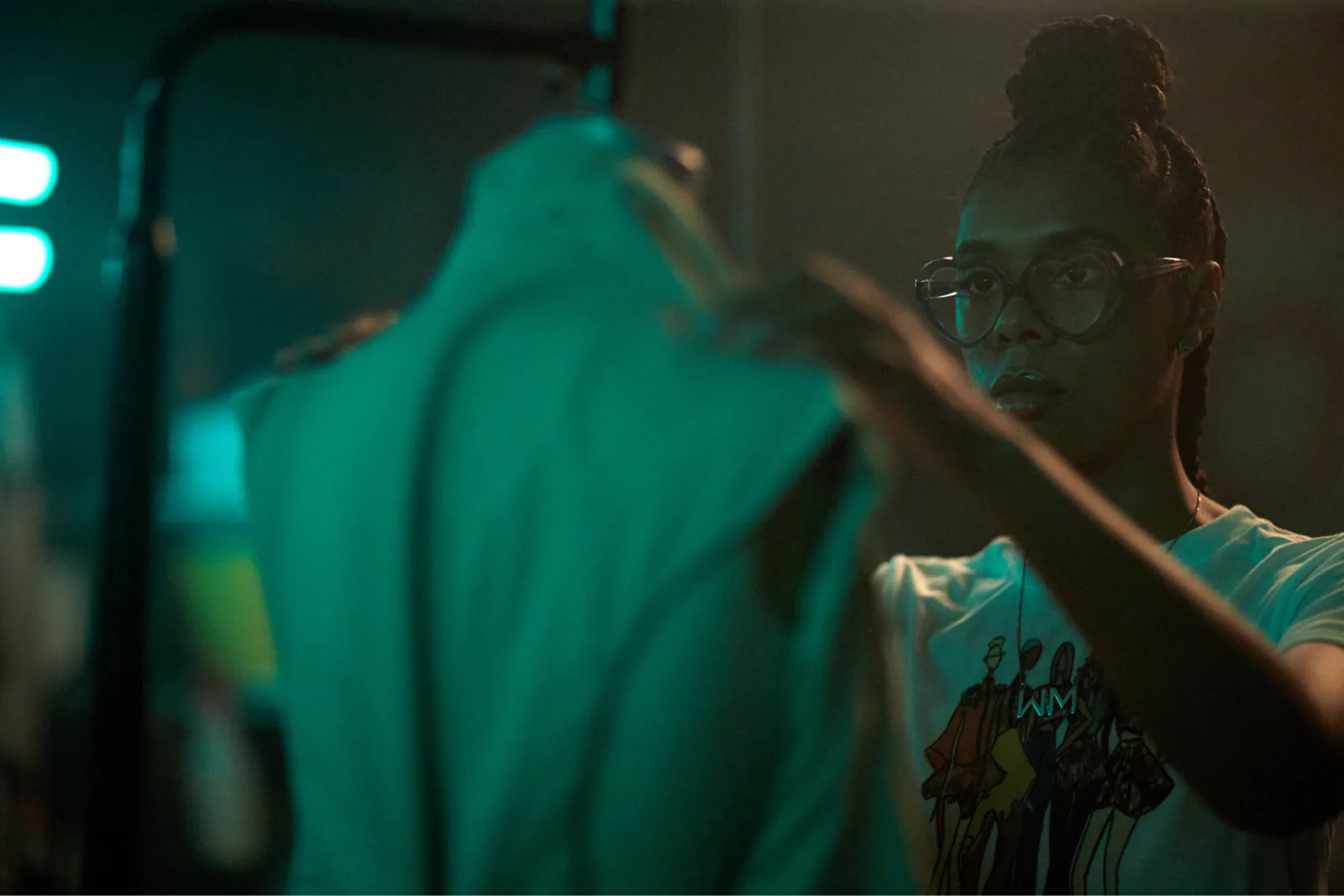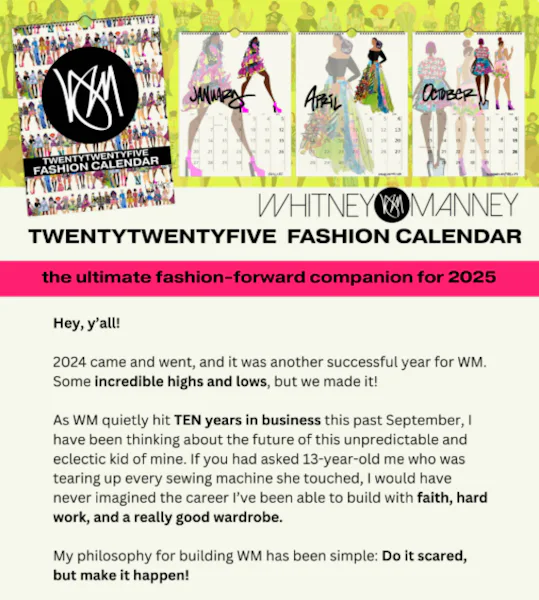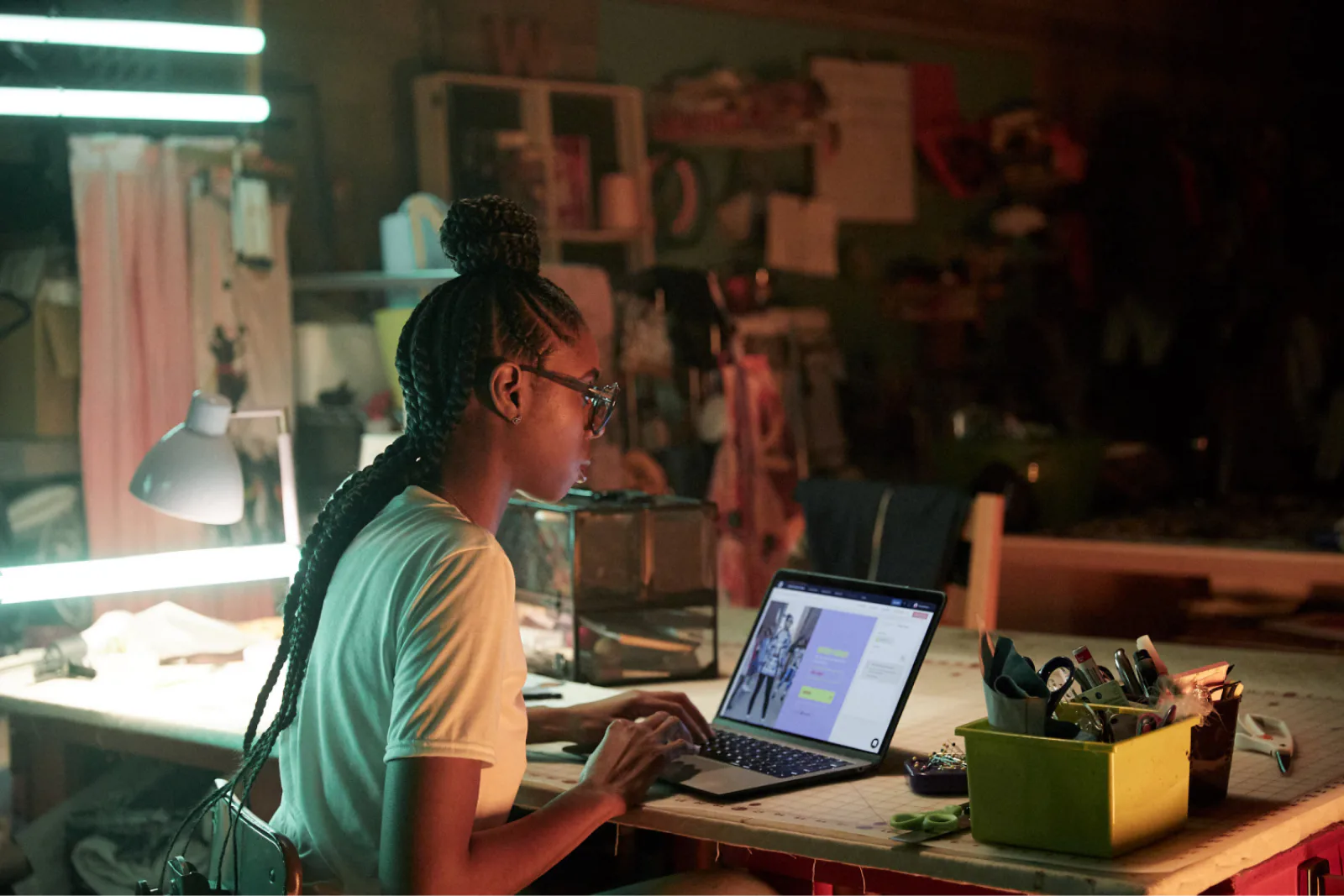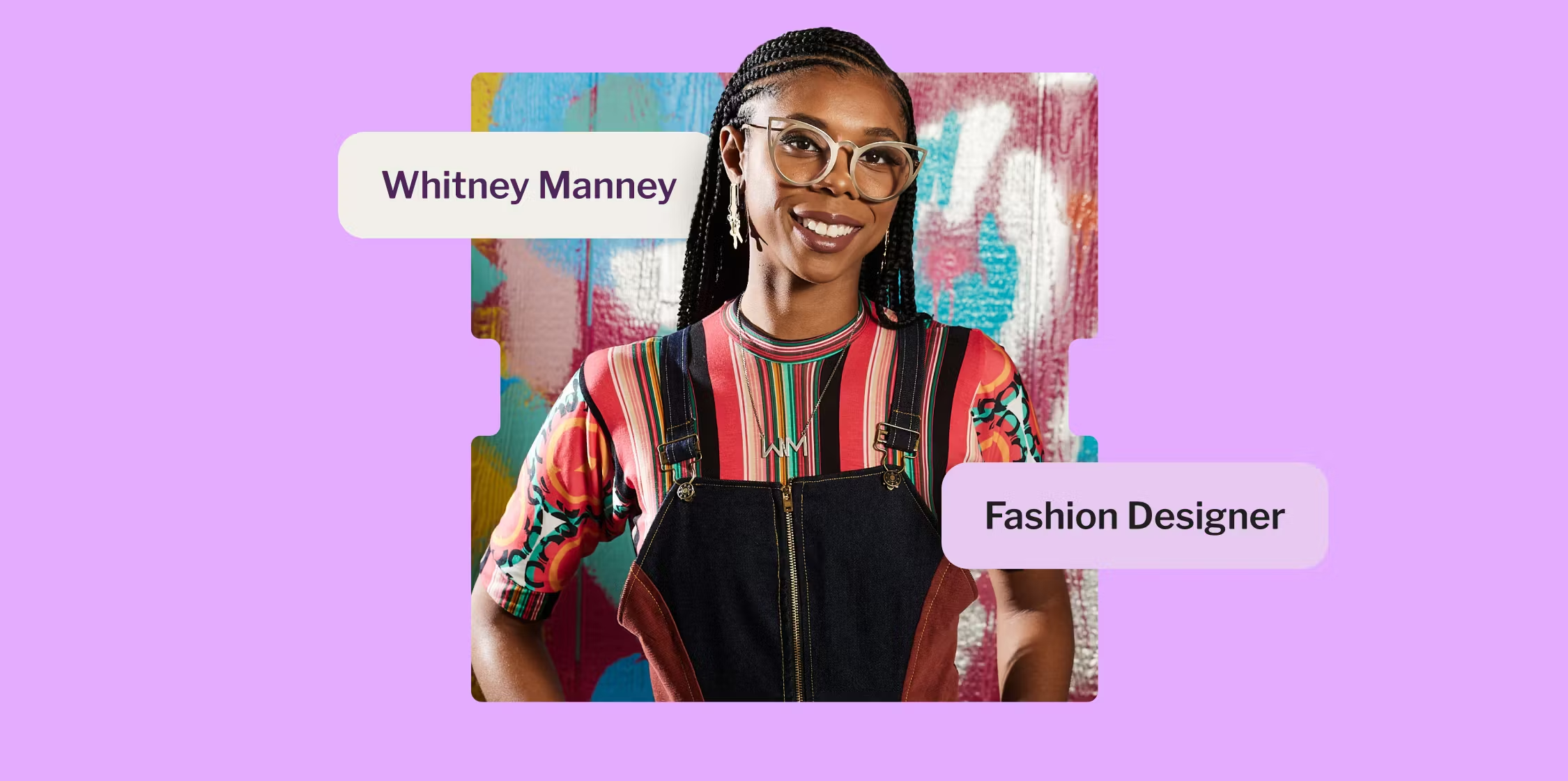Whitney Manney built her brand on social media, but when algorithms stopped working, she took control.
Instead of chasing likes and visibility, she turned to email marketing, where she now has a 40% open rate — nearly double the industry average (20-25%) — and direct access to her customers.
We caught up with Whitney to discuss how creators can break free from the algorithm, take ownership of their audience, and build a sustainable business on their terms.
[Kit] Your brand is all about bold colors and wearable art. What drew you to this creative path?
[Whitney] Fashion was never just about clothing for me — it was a way to communicate. I didn’t talk a lot growing up, but I could express myself through what I wore.
When I went to a visual and performing arts high school, everything changed. There were no rules about how we dressed. That gave me the confidence to experiment and show up as who I wanted to be.
When I discovered street art, it shaped how I saw art and textiles. Street artists don’t just paint over a space; they work with it. That’s how I approach design — I see the body as a canvas, and my textiles transform it into wearable art.
When did you realize your designs weren’t just art but a business?
I sold designs in local boutiques while I was still in school and focused on building an online presence wherever I could. Back in the day, I was low-key Tumblr famous. I understood early that press mattered, so I started getting my name in local media.
By the time I graduated, I was already retailing in two stores, showing at Kansas City and St. Louis Fashion Week, and had my website up and running, knowing I was building something bigger.

Many artists struggle with pricing. How did you determine what your work was worth?
I had to learn the hard way. Pricing is still something I struggle with, but one experience changed everything for me.
When I pitched my collaboration with the Kansas City Royals, I submitted a proposal with my pricing. I was terrified they’d negotiate me down. Instead, they said, “Great. Send us the wire info.” That moment hit me hard. I had been undervaluing myself the entire time.
Now, I set my pricing based on the time, materials, and expertise that go into my work — not just what I think people will pay. I also factor in what it costs to run my business, pay collaborators, and keep my brand sustainable.
Social media is a huge part of your brand’s success. What was your first big moment online?
Growing up, the message was always, “You have to leave Kansas City to make something of yourself.”
But when I started putting my work on social media, I connected with people in New York, Chicago, and LA who didn’t care where I was from. They just liked my work.
That changed everything for me. It made me realize I didn’t have to limit myself to my local market. I wasn’t just a local artist — I was a Kansas City-based artist with a global audience.
You’ve built an incredibly engaged audience. What’s your secret?
I show up as my true, authentic self. No curation, no perfection — just the reality of running a creative business.
I document my process every day. My audience sees me clock in and clock out on Instagram Stories, so they know when I start and finish my work. I show my process, my materials, and what’s inspiring me.
I’m not just selling products — I’m bringing people into my world and building community.
I use storytelling in every part of my business. I share behind-the-scenes moments in my studio or take people through the challenges of creating a new collection. My social captions and newsletters read like journal entries because I want my audience to feel like they’re right there with me.

Social media has opened up incredible opportunities for creators, but it’s also changed a lot in the past few years. What’s been your experience as a Black creator navigating these spaces today?
It’s exhausting. We create culture, we create trends, but when it comes to visibility and monetization, we’re constantly fighting.
I’ve seen firsthand how Black creators get left out of major opportunities even when we’re setting the trends. Brands will use our work for inspiration but won’t compensate us. Platforms will highlight us for a month and then stop amplifying our content the moment it’s no longer a PR win.
We’ve seen platforms like Meta roll back policies that previously addressed hate speech and misinformation. Have you noticed a difference in the way online spaces feel?
Absolutely. Comment sections have become hostile, algorithm bias is real, and platform support for marginalized creators has faded.
It’s not just that the protections are gone — it’s that the people who don’t want us here know they’re gone. There’s a level of safety that’s missing now. I have to be extra mindful of how my work is framed, who it reaches, and whether I want to open my comment section at all.
Have you ever had to deal with harassment, shadowbanning, or algorithm bias as a Black creator? How do you handle it?
I’ve seen my content pushed to the completely wrong audience — people who aren’t my customers and don’t support my work. And I know for a fact that my content isn’t even reaching the people who actually follow me.
I’ve also had moments where I had to alter my marketing choices just to protect myself. Even when I was choosing models for a recent project, I had to stop and think: Am I going to get hate comments for casting all Black models? That’s not something white creators have to think about.
What do you think platforms should be doing to better support Black creators and create safer spaces?
They should listen. Every time Meta or Instagram announces an update, creators flood the comments, saying, “This isn’t what we asked for.” But nothing changes.
Instead of performative campaigns, I’d rather see platforms actually amplify Black creators consistently. Give us the same visibility, the same monetization tools, and the same algorithm support as our white counterparts.
What do you wish more people knew about what it’s like to be a Black creator?
People see the success stories, but they don’t see how much harder we have to work to get there.

Most of us don’t have generational wealth, industry connections, or mentorship. We’re figuring this out as we go, and we’re doing it while navigating bias at every level—pricing, brand deals, platform visibility, and even customer interactions.
How does email marketing and owning your audience protect you from algorithm shifts?
I refuse to let someone else’s platform dictate my reach or income. My email list is mine. I don’t have to worry about shadowbanning, suppression, or disappearing engagement overnight.
With email, I’m in control. When I launch a new collection, introduce a collaboration, or have a story to tell, I don’t have to fight an algorithm; I go straight to the inbox.
How does Kit help you move your audience off social media and into owned channels?
Social media has been great for visibility, but it’s not something I can rely on long-term. Algorithms change, content gets buried, and I don’t want a platform I don’t control dictating how my audience interacts with me.
That’s why I’ve shifted focus to email marketing because it’s a space I actually own.
With Kit, I don’t have to fight to be seen. If someone joins my email list, they’re choosing to stay connected to me, and I can talk directly to them without worrying about whether the algorithm decides to show my content that day.
Email also has a completely different level of engagement than social media. A follow on Instagram is easy, but subscribing to a newsletter? That’s intentional. That person is actively choosing to be part of my community.
A newsletter has a more committed audience, making it more valuable than a passive social media following.
Every time I send a newsletter, I make sales. That doesn’t happen on Instagram.
What email strategies have helped you generate sales or deeper engagement?
Segmenting my audience works really well.
When I launched my capsule collection, I created a whole email series leading up to it — one email about textile designs, another about fabric choices, and another about styling ideas. People who engaged with those emails got a special notification when the collection launched because I knew they were the most interested.
I also structure my emails to keep people coming back and monitor my open rates, which are around 40%. Some newsletters are about my process, some are updates, and some are strictly product-focused.
You don’t have to overthink email. I used to spend so much time trying to craft the perfect newsletter, but now I just focus on making it feel natural.
What’s your workflow for sending emails, engaging with your audience, and selling without spending all day on marketing?
I use a content funnel:
- Blog and social posts: I take notes throughout the week about what I’m working on and turn that into content.
- Newsletter topics: If I find myself talking about a design, a challenge, or an upcoming project a lot, that becomes the foundation of my next email.
- Email automation: I set up emails in advance so they go out when needed, not when I finally find the time to write them.
My workflow is all about making things manageable and sustainable. I might draft a quick email while waiting in line at the fabric store, then refine it later. It doesn’t have to be perfect — it just has to be real.
For other Black creators who may be struggling with visibility or feeling unsupported online, what advice would you give?
You have to own your audience. Social media is a great tool, but it’s not a foundation. If a platform shut down tomorrow, would you still have access to your customers? If the answer is no, you need to start building that now.
What’s next for you? Any projects we should be watching for?
Right now, I’m focused on expanding my wholesale business, licensing my artwork, and refining my process to scale without burnout.
Licensing is a big one for me. I know there’s so much revenue potential I’m leaving on the table. I’ve been working on structuring my designs in a way that makes them easier to license, and I’d love to connect with people in that space to help guide me through it.
Beyond that, I have a few capsule collections in the works, and I’m continuing to take on costume design projects for film, theater, and commercial work. Every new project helps me push my creativity in a different way, and I’m excited to see where it leads.
Want to work with Whitney? Get in touch via her website.
Editor’s note: This interview has been edited for clarity and length.
Whitney didn’t wait for an algorithm — she took control of her business. Now, it’s your turn.
Every email she sends makes a sale. Every subscriber is an engaged customer. She’s not running her business on guesswork and algorithms, and you don’t have to, either.
Your free trial of Kit gives you everything you need to engage, automate, and grow — without relying on social media.
Log in, send your first email, and start building a business on your terms today. Your audience is waiting.




